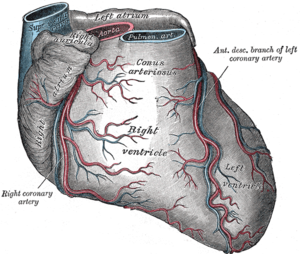 Image via Wikipedia
Image via Wikipedia
In continuation with my previous post on angina pectoris,in this post i will explain the symptoms of unstable angina.
In unstable angina,the chest discomfort or chest pain is similar in quality to the chest pain in individuals with angina pectoris.[symptoms of angina pectoris].
But in case of unstable angina the the chest pain is more severe in intensity and is prolonged in duration.
Unlike chest pain in angina pectoris,in case of unstable angina,the chest discomfort may occur even during rest and sublingual[placing the tablet under the tongue] nitroglycerin may not cause any relief.
This condition is much more serious than stable angina.The chest pain of unstable angina may also be associated with respiratory distress,nausea etc.
If any individual experiences this sort of chest pain,he/she should immediately contact emergency medical services for help.
Please consult this topic, with other reliable internet resources or with your doctor.
Tags:



